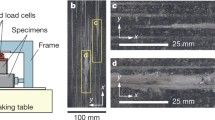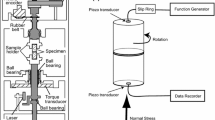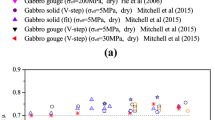Abstract
This paper reviews many of the mechanical properties of faulted and jointed rock under pressure and temperature and in the presence of water. At low effective confining pressures (below about 1 kilobar), the friction strength is quite variable and depends on the frictional resistance between gouge particles or asperities and on the dilatancy of the fault. At higher pressures the friction strength is nearly independent of mineralogy, temperature, and rate, at least for rocks whose friction strength is less than the failure strength. Water tends to slightly weaken the fault. The type of sliding motion, whether stick-slip or stable sliding, is much more affected by environmental and mineralogical factors. In general, stick-slip is dominant at high pressures and low temperatures, in the presence of strong minerals such as quartz and feldspar, in the absence of gouge, for lower surface roughness, and perhaps in the presence of water. The microscopic deformation mechanisms are poorly understood. At low temperatures, cataclasis dominates in rocks containing mostly quartz or feldspar, and plastic deformation in rocks containing mostly calcite or platy silicates. At high temperature most minerals deform plastically, producing a greater temperature-and rate-dependence of the friction strength. Glass has been found in some sliding surfaces in sandstone.
Similar content being viewed by others
References
Jaeger, J. C. (1959),The frictional properties of joints in rocks, Geofis. Pura. Appl.43, 148–158.
Brace, W. F. andByerlee, J. D. (1966),Stick-slip as a mechanism for ear thquakes, Science153, 990.
Jaeger, J. C. andCook, N. G. W.,Fundamentals of Rocks Mechanics, Chapman and Hall, London, second ed. 1976, 585 pp.
Brace, W. F. (1968),Current laboratory studies pertaining to earthquake predictions, Tectonophysics6(1), 75.
Brace, W. F. (1969),Laboratory studies pertaining to earthquakes, Trans. N.Y. Acad. Sci., Ser, II,31(7), 892.
Brace, W. F. (1972),Laboratory studies of stick-slip and their application to earthquakes, Tectonophysics14(3/4), 189–200.
Brace, W. F. (1974),Experimental studies of seismic behavior of rocks under crustal conditions, Eng. Geol.8, 109–127.
Brace, W. F.,Recent laboratory studies of earthquake mechanics and prediction, U.S.-Japan Seminar on Earthquake Precursors, Tokyo, Japan, Jan. 1977, preprint.
Mauer, W. C. (1965),Shear failure of rock under compression, J. Soc. Petrol. Eng.5(2), 167.
Byerlee, J. D. (1968),Brittle-ductile transition in rocks, J. Geophys. Res.73(14), 4741–4750.
Stesky, R. M., Brace, W. F., Riley, D. K. andRobin, P.-Y. F. (1974),Friction in faulted rock at high temperature and pressure, Tectonophysics23, 177–203.
Logan, J. M., Iwasaki, T. andFriedman, M. (1973),Experimental investigation of sliding friction in multilithologic specimens in Geological Factors in Rapid Excavation, Pincus (ed.), Geol. Soc. Amer. Eng. Case History 9, 55–67.
Ohnaka, M. (1975),Frictional characteristics of typical rocks, Jour. Phys. Earth23, 87–112.
Dieterich, J. H. (1972),Time dependent friction in rocks, J. Geophys. Res.77(2), 3690–3697.
Brace, W. F. andStesky, R. M. (1973),Time-dependence of frictional sliding in gabbro at high temperature and pressure (Abstr.), Am. Geophys. Union, Trans.54(4), 466.
Jaeger, J. C. (1971),Friction of rocks and stability of rock slopes, Geotechnique21(2) 97–134.
Newland, P. L. andAllezy, B. H. (1957)Volume changes in drained triaxial tests on granular materials, Geotechnique7, 17–34.
Rowe, P. W., Barden, L. andLee, I. K. (1964),Energy components during the triaxial cell and direct shear tests, Geotechnique14, 247–261.
Barton, N. (1976),The shear strength of rock and rock joints, Int. J. Rock Mech. Min. Sci.13, 255–279.
Schneider, H. J. (1976),The friction and deformation behaviour of rock joints, Rock Mech8, 169–184.
Scholz, C. H., Molnar, P. andJohnson, T. (1972),Detailed studies of frictional sliding of granite and implications for the earthquake mechanism, J. Geophys. Res.77(32), 6392–6406.
Chaplin, T. K.,Shearing, dilatancy and crushing phenomena in granular materials, Struct., Sol. Mech. and Eng. Design, Proc. Southampton, 1969, Civil Eng. Plat'ls. Conf., 951–962.
Billam, J.,Some aspects of the behaviour of granular materials at high pressure, Proc. Roscoe Memorial Symp., Mar. 1971, Stress-Strain Behavior of Soils, G. T. Foulis, S.O.A. Bell St. Henleyon-Thames, 69–80.
Koerner, R. M. (1970),Effect of particle characteristics on soil strength, J. Soil Mech. Found. Div. ASCE96(SM4), 1221–1234.
Koerner, R. M. (1970),Behavior of single mineral soils in triaxial shear, J. Soil Mech. Found. Div.96(SM4), 1373–1390.
Vesic, A. S. andClough, G. W. (1968),Behaviour of granular materials under high stresses. J. Soil Mech. Found. Div.94(SM3), 661–688.
Jaeger, J. C. andCook, N. G. W.,Friction in granular materials, Proc. Int. Conf. Struct. and Solid Mech. Civ. Eng., Southampton, U.K., Paper 20, 1970, 257–266.
Engelder, J. T., Logan, J. M. andHandin, J. (1975),The sliding characteristics of sandstone on quartz fault-gouge, Pure and Appl. Geophys.113, 69–86.
Abey, A. E. andHeard, H. C. (1973),Frictional characteristics of granite and granite-serpentine to high pressures (Abstr.), Trans. Am. Geophys. Un.54(4), 464.
Drennon, C. B. andHandy, R. L. (1972),Stick-slip of lightly-loaded, limestone, Int. J. Rock Mech Min. Sci.9, 603–615.
Friedman, M., Logan, J. M. andRigert J. M. (1974),Glass-indurated quartz gouge in sliding-friction experiments on sandstone, Bull. Geol. Soc. Amer.85, 937–942.
Donath, F. A., Fruth Jr., L. S. andOlsson, W. A.,Experimental study of frictional properties of faults in New Horizons in Rock Mechanics, 14th Symposium on Rock Mech., University Park, Pennsylvania, June 11–14, 1972, 189–222.
Olsson, W. A. (1974),Effects of temperature, pressure and displacement rate on the frictional characteristics of a limestone, Int. J. Rock Mech. Min. Sci.11, 267–278.
Byerlee, J. D. (1967),Frictional characteristics of granite under high confining pressure, J. Geophys. Res.72(14), 3639–3648.
Blackwell, M. L. (1973),The influence of pore fluids on the frictional properties of quartzose sandstone, M.S. thesis, Texas, A. and M. Univ., 69 pp.
Rutter, E. H. (1972),The influence of interstitial water on the rheological behavior of calcite rocks. Tectonophysics14(1), 13–34.
Goodman, R. E.,Pore pressure in intact and jointed rocks induced by deformation (Abstr.), Int. Colloquium Seismic Effects of Reservoir Impounding, Roy. Soc. Lond., 1973, March.
Brace, W. F. andMartin, R. J. (1968),A test of the law of effective stress for crystalline rocks of low porosity, Int. J. Rock Mech. Min. Sci.5, 415.
Healy, K. A.,The dependence of dilation in sand on rate of shear strain, Ph. D. thesis, Civil Eng., M. I. T., Cambridge, Mass., 1963.
Byerlee, J. D. andBrace, W. F. (1968),Stick-slip, stable sliding, and earthquakes — effect of rock type, pressure, strain rate, and stiffness, J. Geophys. Res.73, 6031.
Jackson, R. E. andDunn, D. E. (1973),Sliding friction and stick-slip related to foliation grain size and composition (Abstr.), Am. Geophys. Union Trans.54(4), 464.
Brace, W. F. andByerlee, (1970),California earthquakes: why only, shallow focus? Science168, 1573.
Scholz, C. H. andEngelder, J. T. (1976),The role of asperity indentation and ploughing in rock friction, Int. J. Rock. Mech. Min. Sci.13, 149–163.
Friedman, M., Logan, J. M. andRigert, J. A. (1974),Glass-indurated quartz gouge in sliding-friction experiments on sandstone, Bull. Geol. Soc. Am.85(6), 937–942.
Jackson, R. E. andDunn, D. E. (1974),Experimental sliding friction and cataclasis of foliated rocks Int. J. Rock Mech. Min. Sci.11(6), 235–250.
Engelder, J. T. (1974),Cataclasis and the generation of fault gouge, Bull. Geol. Soc. Am.85, 1515–1522.
Engelder, J. T. andMcKee, T. R.,Electron microscopical study of indurated quartz gouges, 31st Annual Meeting, Electron Microscopy Soc. Am., Proc., 1973, 214–215.
Stesky, R. M. (1978),Mechanisms of high temperature frictional sliding in Westerly granite, Can. J. Earth Sci., in press.
Stesky, R. M. (1975),Acoustic emission during high-temperature frictional sliding, Pure and Appl. Geophys.113(1/2), 31–44.
Mitchell, J. K., Singh, A. andCampanella, R. G. (1969),Bonding, effective stresses, and strength of soils, J. Soil Mech. Found. Div.95(DM5), 1219–1246.
Scholz, C. H. andMartin, R. J. (1971),Crack growth and static fatigue in quartz, Jour. Amer. Ceramic Soc.54(9), 474.
Goetze, C. (1971),High temperature rheology of Westerly granite, J. Geophys. Res.76(5), 1223–1230.
Mitchell, J. K. (1964),Shearing resistance of soils as rate process. J. Soil Mech. Found. Div.90(SM1), 29–61.
Christensen, R. J., Swanson, S. R. andBrown, W. S.,Torsioal, shear measurements of the frictional properties of Westerly granite, Final Report, Def. Nucl. Agency Contract No. DNA001-72-C-0026, 1973, 48 pp.




